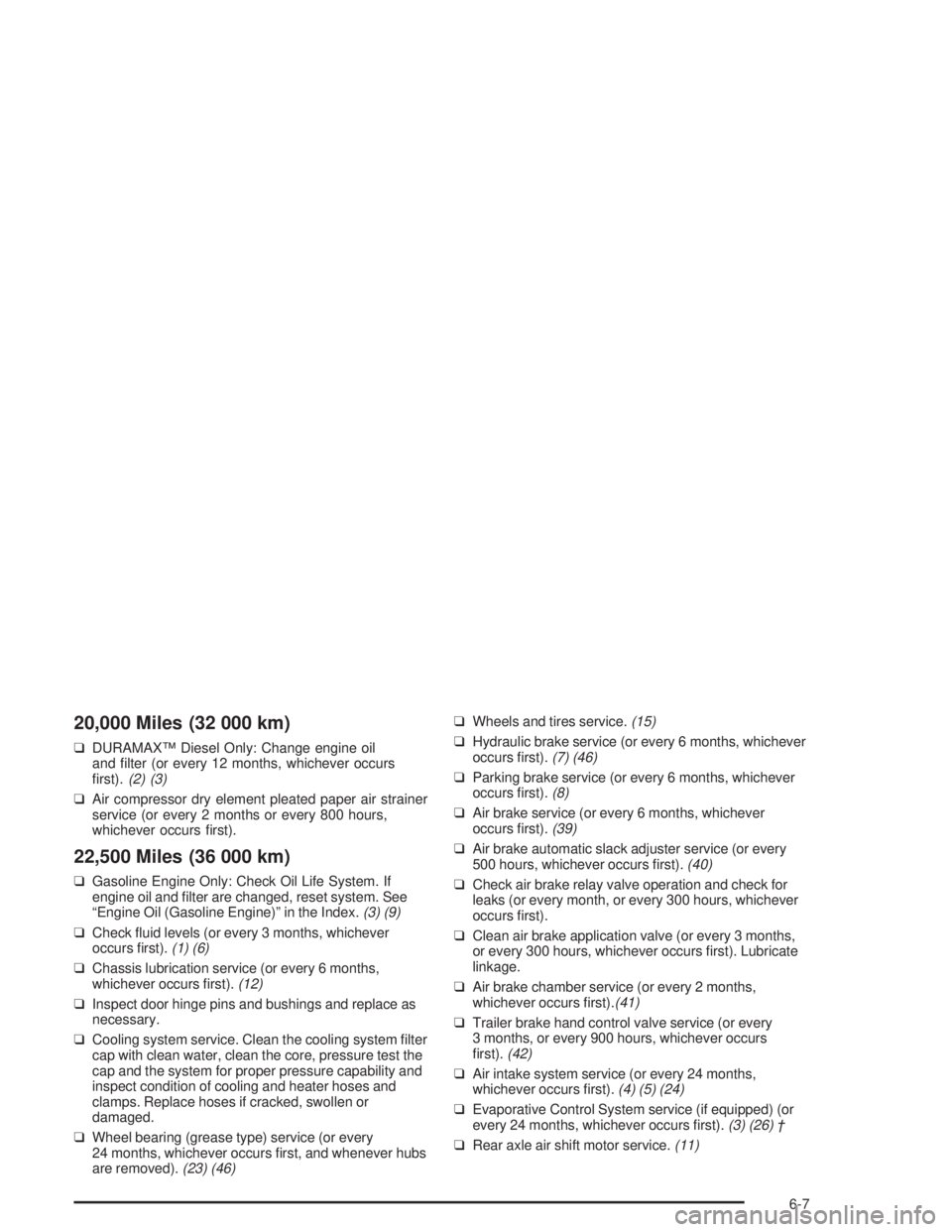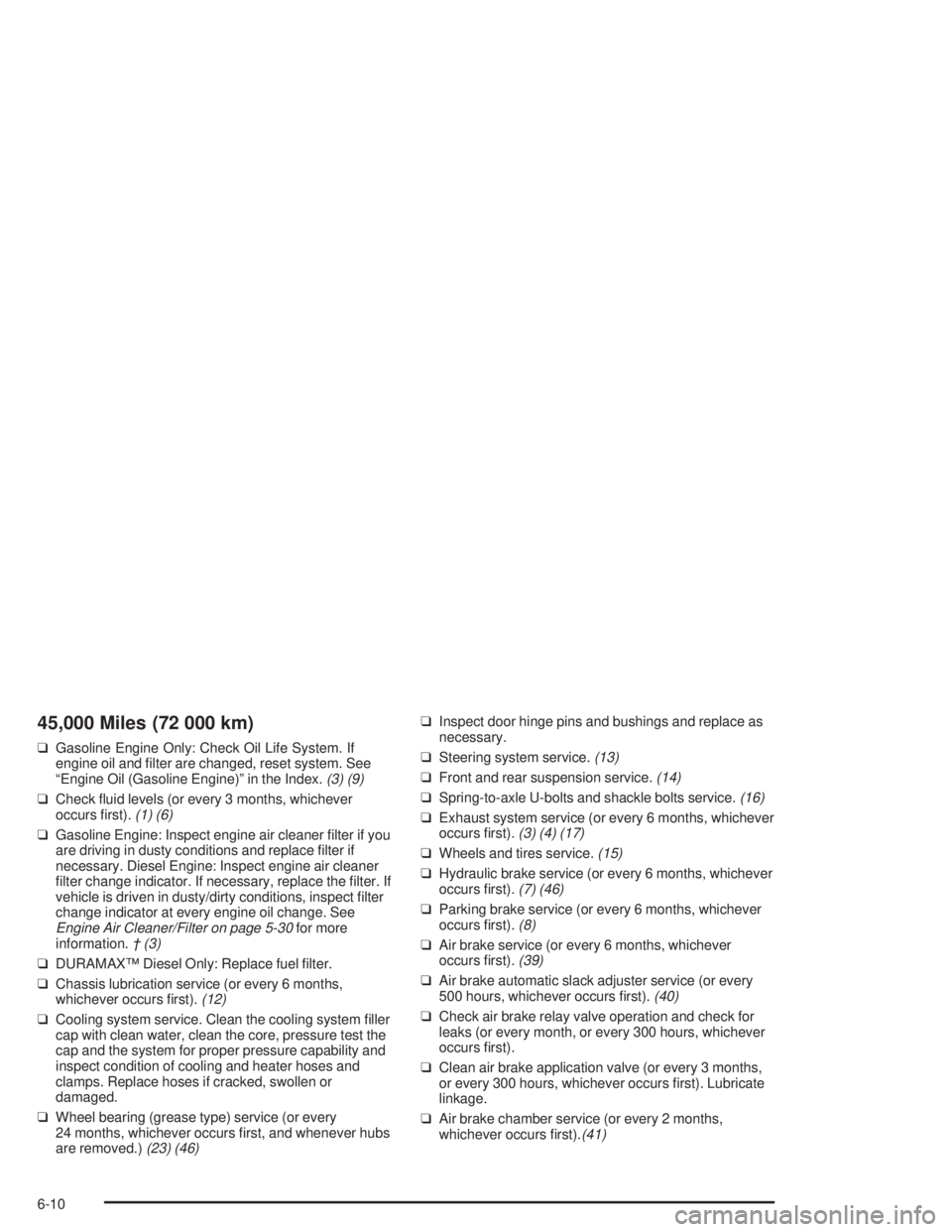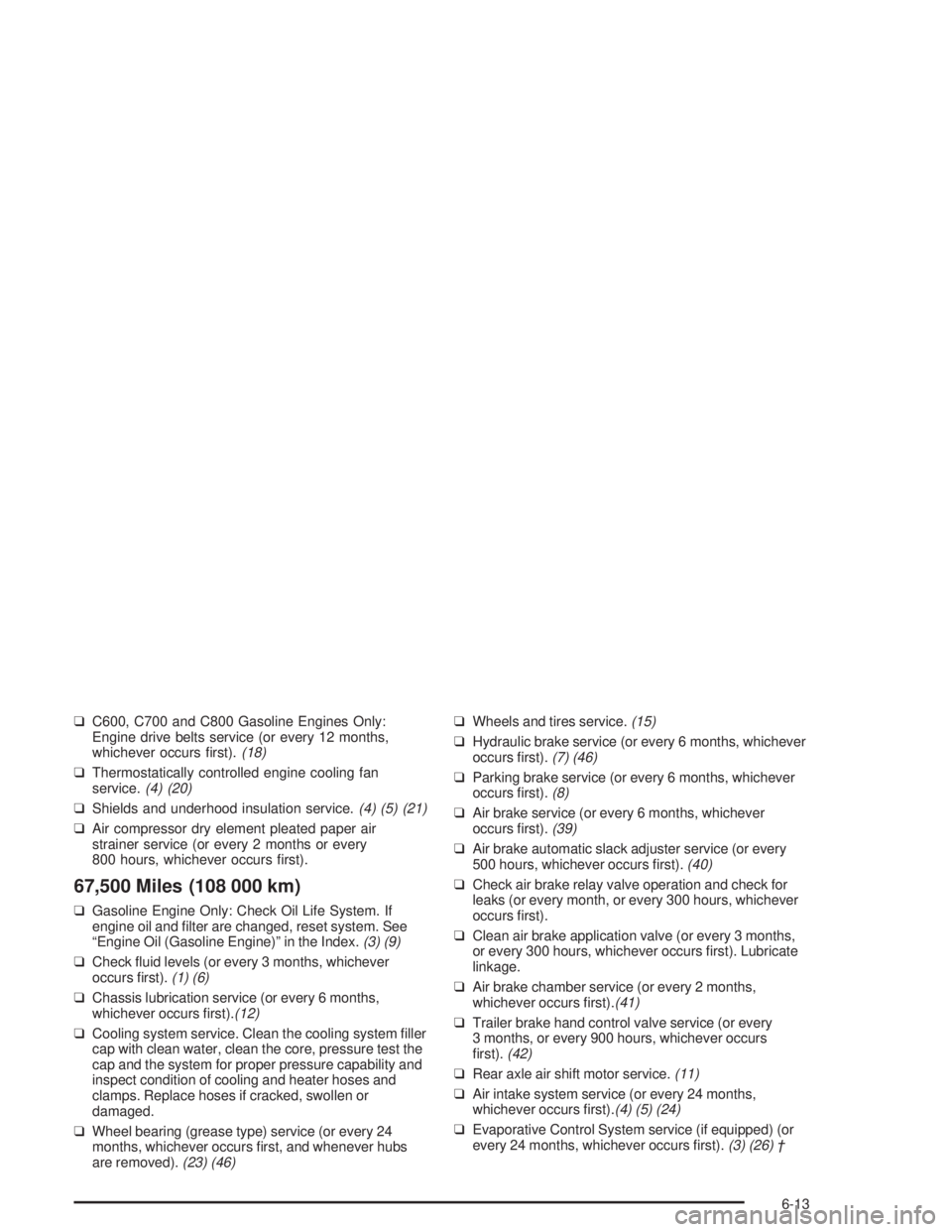2004 CHEVROLET KODIAK oil type
[x] Cancel search: oil typePage 215 of 366

Biodiesel is produced from vegetable oils or animal fat
that have been chemically modified to reduce the
possibility of damage to your fuel system and engine.
Higher concentration (i.e., greater than B5)
biodiesel-containing fuels or the use of unmodified
bio-oils blended into diesel fuel at any concentration is
not recommended and could damage your fuel
system and engine. Such damage would not be covered
by your warranty. If there are questions about the
biodiesel-containing fuels you are using, contact your
fuel supplier.
Diesel fuel may foam when you fill your tank. This can
cause the automatic pump nozzle to shut off, even
though your tank is not full. If this happens, just wait for
the foaming to stop and then continue to fill your tank.
{CAUTION:
Heat coming from the engine may cause the
fuel to expand and force the fuel out of your
tank. If something ignites the fuel, a �re could
start and people could be burned. To help avoid
this, �ll your fuel tank only until the automatic
nozzle shuts off. Do not try to “top it off.”
What Fuel to Use in Canada
Canadian fuels are blended for seasonal changes.
Diesel Type “A” fuel is blended for better cold weather
starting (below 0°F or−18°C); however, you may
notice some power and fuel economy loss. If Type “A”
fuel is used in warmer temperatures, stalling and
hard starting may occur. Diesel Type “B” fuel is blended
for temperatures above 0°F (−18°C). The emission
control system requires the use of diesel fuel with
low-sulfur (.05% by weight) content. Both low- and
higher-sulfur fuels will be available in Canada. Only
low-sulfur diesel fuels are available in the United States.
It is important that diesel-powered trucks are refueled
only with low-sulfur fuel. Use of fuels with higher-sulfur
content will affect the function of the emission
components and may cause reduced performance,
excessive smoke and unpleasant odor.
At a minimum, the diesel fuel you use should meet
specifications CAN/CGSB–3.517–2000 (Low Sulfur
Diesel) in Canada. In addition, the Engine Manufacturers
Association (EMA) has identified properties of an
improved diesel fuel for better engine performance and
durability (FQP-1A). Diesel fuels corresponding to
the EMA description could provide better starting, less
noise and better vehicle performance. If there are
questions about the fuel you are using, contact your fuel
supplier.
5-9
Page 259 of 366

Item Number Item Remarks
1 Brake Camshaft** One fitting each (apply sparingly).
2 Steering Column Slip Joint* One fitting.
3 Steering Drag Link Ends One fitting each end.
4 Pivot Points and Hinges Apply chassis lubricant.
5 Pivot Points and Hinges Apply chassis lubricant.
6 Slack Adjuster** One fitting.
7Brake Cam Roller Pins at interface of pin
and shoe**Apply engine oil.
8 Front Steering KnucklesOne fitting each side, lower bushing.
(Hand-operated grease gun only.) Hand-pack
upper bearing.
9 Front Wheel Bearings Hand-pack or lubricate.
10 Steering Tie Rod Ends One fitting each end.
11 Spring Slip Pads* (Multi-leaf Only) Apply chassis lubricant.
12 Clutch Release Bearing* Cup or fitting.
13 Battery Terminal (except “ST” type) Keep coated with petroleum jelly.
14 Transmission Fill to level of filler plug.
15 Propshaft Slip JointsLubricate with GM Part No. 1051344 Wheel Bearing
Lubricant.
16 Parking Brake Clevis Pin$ Apply chassis lubricant.
17 Parking Brake Lever Pivot*, $ Apply chassis lubricant.
18Clutch Release Cross Shaft,
Master Cylinder$Apply chassis lubricant, fill to 1/4 inch (6 mm)
below opening.
5-53
Page 267 of 366

Rear Axle
When to Check and Change Lubricant
Refer to the Maintenance Schedule to determine
how often to check the lubricant and when to change it.
SeeScheduled Maintenance on page 6-5.
How to Check Lubricant
To get an accurate reading, the vehicle should be on a
level surface.
If the level is below the bottom of the filler plug hole,
you’ll need to add some lubricant. Add enough lubricant
to raise the level to the bottom of the filler plug hole.
What to Use
Refer to the Maintenance Schedule to determine what
kind of lubricant to use. SeePart C: Recommended
Fluids and Lubricants on page 6-29.
Rear Axle Shift Motor
When to Check and Change Fluid
If you have an optional air-shift two-speed, controlled
traction, or locking differential type rear axle, a good time
to check the fluid level in the axle shift motor is when
the rear axle lubricant is checked. Use refrigerant
oil (shift motor only).
How to Check Fluid
Remove the plug on the front plate of the axle shift
motor, add enough fluid to raise the level to the bottom
of the filler plug hole, then replace the plug.
What to Use
Refer to your Maintenance Schedule to determine what
kind of lubricant to use. SeePart C: Recommended
Fluids and Lubricants on page 6-29.
5-61
Page 317 of 366

20,000 Miles (32 000 km)
❑DURAMAX™ Diesel Only: Change engine oil
and filter (or every 12 months, whichever occurs
first).(2) (3)
❑Air compressor dry element pleated paper air strainer
service (or every 2 months or every 800 hours,
whichever occurs first).
22,500 Miles (36 000 km)
❑Gasoline Engine Only: Check Oil Life System. If
engine oil and filter are changed, reset system. See
“Engine Oil (Gasoline Engine)” in the Index.(3) (9)
❑Check fluid levels (or every 3 months, whichever
occurs first).(1) (6)
❑Chassis lubrication service (or every 6 months,
whichever occurs first).(12)
❑Inspect door hinge pins and bushings and replace as
necessary.
❑Cooling system service. Clean the cooling system filter
cap with clean water, clean the core, pressure test the
cap and the system for proper pressure capability and
inspect condition of cooling and heater hoses and
clamps. Replace hoses if cracked, swollen or
damaged.
❑Wheel bearing (grease type) service (or every
24 months, whichever occurs first, and whenever hubs
are removed).(23) (46)❑Wheels and tires service.(15)
❑Hydraulic brake service (or every 6 months, whichever
occurs first).(7) (46)
❑Parking brake service (or every 6 months, whichever
occurs first).(8)
❑Air brake service (or every 6 months, whichever
occurs first).(39)
❑Air brake automatic slack adjuster service (or every
500 hours, whichever occurs first).(40)
❑Check air brake relay valve operation and check for
leaks (or every month, or every 300 hours, whichever
occurs first).
❑Clean air brake application valve (or every 3 months,
or every 300 hours, whichever occurs first). Lubricate
linkage.
❑Air brake chamber service (or every 2 months,
whichever occurs first).(41)
❑Trailer brake hand control valve service (or every
3 months, or every 900 hours, whichever occurs
first).(42)
❑Air intake system service (or every 24 months,
whichever occurs first).(4) (5) (24)
❑Evaporative Control System service (if equipped) (or
every 24 months, whichever occurs first).(3) (26) †
❑Rear axle air shift motor service.(11)
6-7
Page 320 of 366

45,000 Miles (72 000 km)
❑Gasoline Engine Only: Check Oil Life System. If
engine oil and filter are changed, reset system. See
“Engine Oil (Gasoline Engine)” in the Index.(3) (9)
❑Check fluid levels (or every 3 months, whichever
occurs first).(1) (6)
❑Gasoline Engine: Inspect engine air cleaner filter if you
are driving in dusty conditions and replace filter if
necessary. Diesel Engine: Inspect engine air cleaner
filter change indicator. If necessary, replace the filter. If
vehicle is driven in dusty/dirty conditions, inspect filter
change indicator at every engine oil change. See
Engine Air Cleaner/Filter on page 5-30for more
information.† (3)
❑DURAMAX™ Diesel Only: Replace fuel filter.
❑Chassis lubrication service (or every 6 months,
whichever occurs first).(12)
❑Cooling system service. Clean the cooling system filler
cap with clean water, clean the core, pressure test the
cap and the system for proper pressure capability and
inspect condition of cooling and heater hoses and
clamps. Replace hoses if cracked, swollen or
damaged.
❑Wheel bearing (grease type) service (or every
24 months, whichever occurs first, and whenever hubs
are removed.)(23) (46)❑Inspect door hinge pins and bushings and replace as
necessary.
❑Steering system service.(13)
❑Front and rear suspension service.(14)
❑Spring-to-axle U-bolts and shackle bolts service.(16)
❑Exhaust system service (or every 6 months, whichever
occurs first).(3) (4) (17)
❑Wheels and tires service.(15)
❑Hydraulic brake service (or every 6 months, whichever
occurs first).(7) (46)
❑Parking brake service (or every 6 months, whichever
occurs first).(8)
❑Air brake service (or every 6 months, whichever
occurs first).(39)
❑Air brake automatic slack adjuster service (or every
500 hours, whichever occurs first).(40)
❑Check air brake relay valve operation and check for
leaks (or every month, or every 300 hours, whichever
occurs first).
❑Clean air brake application valve (or every 3 months,
or every 300 hours, whichever occurs first). Lubricate
linkage.
❑Air brake chamber service (or every 2 months,
whichever occurs first).(41)
6-10
Page 323 of 366

❑C600, C700 and C800 Gasoline Engines Only:
Engine drive belts service (or every 12 months,
whichever occurs first).(18)
❑Thermostatically controlled engine cooling fan
service.(4) (20)
❑Shields and underhood insulation service.(4) (5) (21)
❑Air compressor dry element pleated paper air
strainer service (or every 2 months or every
800 hours, whichever occurs first).
67,500 Miles (108 000 km)
❑Gasoline Engine Only: Check Oil Life System. If
engine oil and filter are changed, reset system. See
“Engine Oil (Gasoline Engine)” in the Index.(3) (9)
❑Check fluid levels (or every 3 months, whichever
occurs first).(1) (6)
❑Chassis lubrication service (or every 6 months,
whichever occurs first).(12)
❑Cooling system service. Clean the cooling system filler
cap with clean water, clean the core, pressure test the
cap and the system for proper pressure capability and
inspect condition of cooling and heater hoses and
clamps. Replace hoses if cracked, swollen or
damaged.
❑Wheel bearing (grease type) service (or every 24
months, whichever occurs first, and whenever hubs
are removed).(23) (46)❑Wheels and tires service.(15)
❑Hydraulic brake service (or every 6 months, whichever
occurs first).(7) (46)
❑Parking brake service (or every 6 months, whichever
occurs first).(8)
❑Air brake service (or every 6 months, whichever
occurs first).(39)
❑Air brake automatic slack adjuster service (or every
500 hours, whichever occurs first).(40)
❑Check air brake relay valve operation and check for
leaks (or every month, or every 300 hours, whichever
occurs first).
❑Clean air brake application valve (or every 3 months,
or every 300 hours, whichever occurs first). Lubricate
linkage.
❑Air brake chamber service (or every 2 months,
whichever occurs first).(41)
❑Trailer brake hand control valve service (or every
3 months, or every 900 hours, whichever occurs
first).(42)
❑Rear axle air shift motor service.(11)
❑Air intake system service (or every 24 months,
whichever occurs first).(4) (5) (24)
❑Evaporative Control System service (if equipped) (or
every 24 months, whichever occurs first).(3) (26) †
6-13
Page 326 of 366

❑Gasoline Engine: Replace engine air cleaner filter.
Diesel Engine: Inspect engine air cleaner filter
change indicator. If necessary, replace the filter. If
vehicle is driven in dusty/dirty conditions, inspect filter
change indicator at every engine oil change. See
Engine Air Cleaner/Filter on page 5-30for more
information.† (3)
❑DURAMAX™ Diesel Only: Replace fuel filter.
❑Chassis lubrication service (or every 6 months,
whichever occurs first).(12)
❑Cooling system service. Clean the cooling system
filler cap with clean water, clean the core, pressure
test the cap and the system for proper pressure
capability and inspect condition of cooling and heater
hoses and clamps. Replace hoses if cracked,
swollen or damaged.
❑Wheel bearing (grease type) service (or every
24 months, whichever occurs first, and whenever
hubs are removed).(23) (46)
❑Replace fuel filter(s) (or every 12 months, whichever
occurs first).(3)
❑Steering system service.(13)
❑Front and rear suspension service.(14)
❑Spring-to-axle U-bolts and shackle bolts service.(16)
❑Exhaust system service (or every 6 months,
whichever occurs first).(3) (4) (17)❑Inspect door hinge pins and bushings and replace as
necessary.
❑Wheels and tires service.(15)
❑Hydraulic brake service (or every 6 months,
whichever occurs first).(7) (46)
❑Parking brake service (or every 6 months, whichever
occurs first).(8)
❑Air brake service (or every 6 months, whichever
occurs first).(39)
❑Air brake automatic slack adjuster service (or every
500 hours, whichever occurs first).(40)
❑Check air brake relay valve operation and check for
leaks (or every month, or every 300 hours, whichever
occurs first).
❑Clean air brake application valve (or every 3 months,
or every 300 hours, whichever occurs first). Lubricate
linkage.
❑Air brake chamber service (or every 2 months,
whichever occurs first).(41)
❑Trailer brake hand control valve service (or every
3 months, or every 900 hours, whichever occurs
first).(42)
❑C600, C700 and C800 Gasoline Engines Only:
Engine drive belts service (or every 12 months,
whichever occurs first).(18)
6-16
Page 331 of 366

(14)= Check front and rear suspension. Look for
damaged, loose or missing parts or parts showing signs
of wear or lack of lubrication. Replace parts as
needed.
(15)= Adjust tire pressures as indicated on the GVW
Rating label for optimum tire life. SeeTires on page 5-68
for further details. Check tires for excessive or
abnormal wear or damage. Also check for damaged
wheels. Replace wheels and/or tires as needed.
(16)= Check spring-to-axle U-bolts and shackle bolts
for proper torque. See the service manual for torque
sequence and specifications. When parts are replaced,
the torque must be checked and adjusted more often
during the first 6,000 miles (10 000 km). Check torque at
500 miles (800 km) and 2,000 miles (3 000 km) after
first use of parts.
(17)= Check complete exhaust system and cab areas
near the exhaust system for broken, damaged,
missing or out-of-position parts. Also inspect for open
seams, holes, loose connections or other conditions
which could let exhaust fumes seep into the driver
compartment. Needed repairs should be made at once.
To help maintain system integrity, replace exhaust
pipes whenever a new muffler is put on.(18)= Check all gasoline engine drive belts for cracks,
fraying and wear. Replace as needed.
(20)= With the engine off and below normal operating
temperature, check to see that the thermostatically
controlled engine cooling fan can be rotated by hand on
viscous-operated drives. Replace as needed.
(21)= Check shields and underhood insulation for
damage or looseness. Adjust or replace as needed.
23)= Wheel bearing service:
•Grease type – Clean, inspect and lubricate with the
proper wheel bearing grease at designated intervals
or when hubs are removed. SeePart C:
Recommended Fluids and Lubricants on page 6-29.
•Oil-filled type – Some wheel bearings are lubricated
by rear axle lubricant. When you have oil-filled
hubs, use lubricant identical to that used in your rear
axle. Lubricant change intervals are the same for
front and rear axles. However, you must maintain oil
level at the OIL LEVEL mark between change
intervals. SeePart C: Recommended Fluids and
Lubricants on page 6-29.
6-21